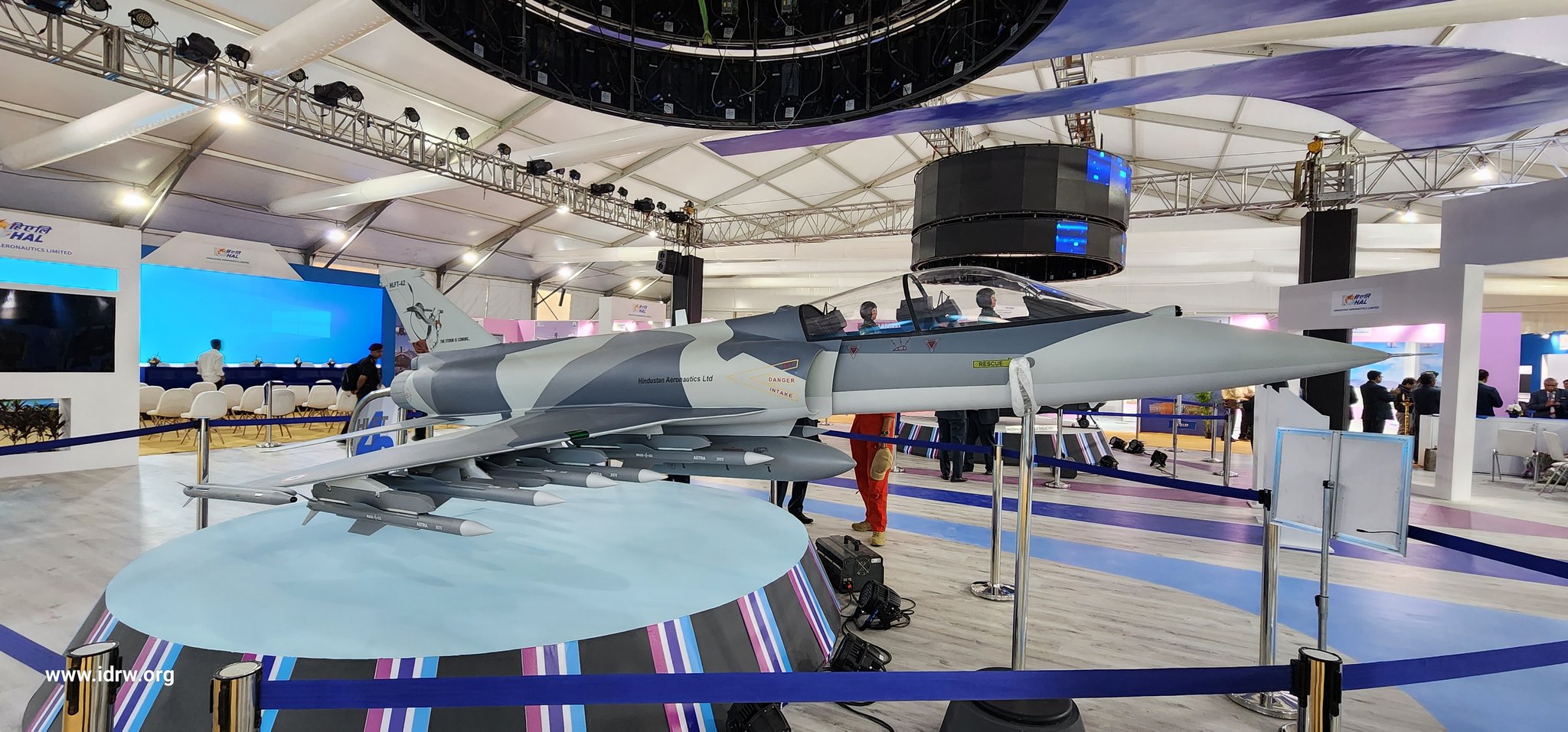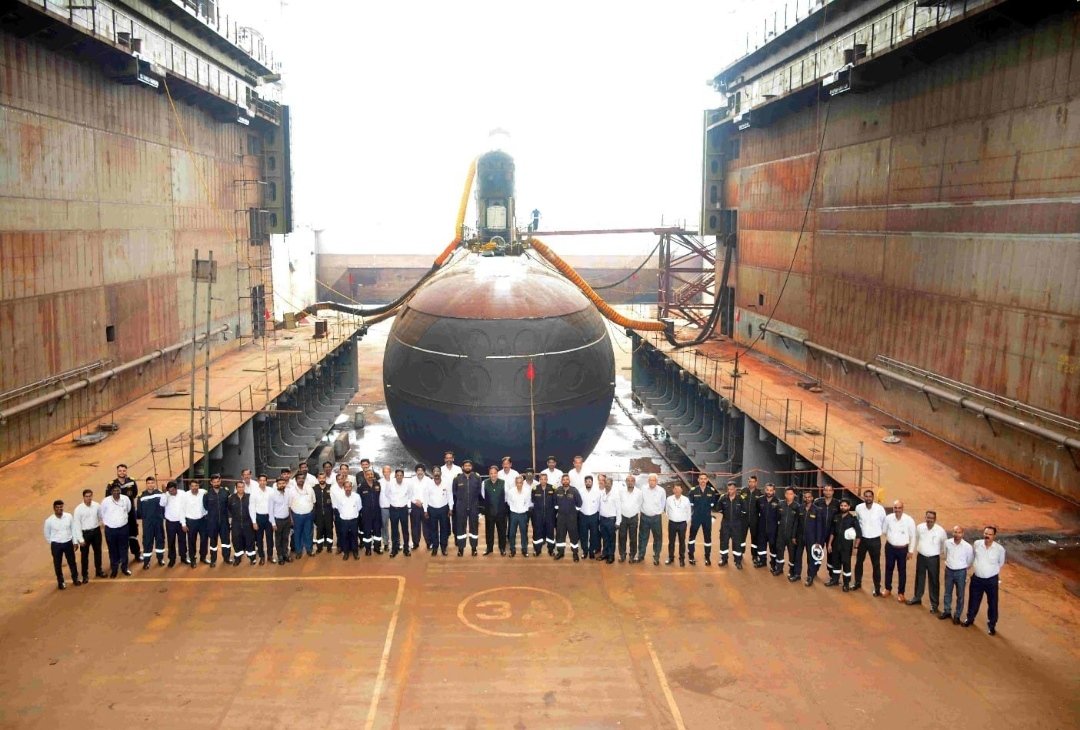AFI
SOURCE: AFI

The Indian Ministry of Defense is gearing up to significantly strengthen the country’s air defense capabilities with the acquisition of nearly 5,000 “Vajra” Air Defense Systems. Developed indigenously by the Defense Research and Development Organization (DRDO), this system promises to be a game-changer, offering several key advantages.
The Vajra, which stands for Very Short Range Air Defense System (VSHORADS), is designed to effectively neutralize a range of aerial threats including enemy aircraft, drones, and helicopters. A significant advantage of the Vajra lies in its cost-effectiveness. Being domestically produced, it offers a powerful defense solution without straining the budget.
Continue readingSOURCE: AFI

Hindustan Aeronautics Limited (HAL) unveiled its HLFT-42 (Hindustan Lead-in Fighter Trainer) design at Aero India 2023, generating a wave of mixed reactions. The single-engine aircraft, adorned with a symbolic image of Maruti, the Hindu God of wind, promised a blend of training capabilities and combat prowess. However, several aspects of the design raise questions about its overall strategy.
The HLFT-42 evokes the HF-24 Marut, a past HAL project. While the Marut spirit of power and agility is commendable, some argue that a 4.5-generation trainer envisioned for 2030 or later seems like a niche concept for pure pilot training. This begs the question: is the HLFT-42 truly a fighter trainer, or a trainer with light combat ambitions?
Continue readingSOURCE: AFI
.jpg)
In 2012, Russia proposed selling several long-range Tupolev Tu-22M3 bombers to India, as part of a comprehensive military package that included the leasing of two Akula-class nuclear submarines and the acquisition of the aircraft carrier ‘Admiral Gorshkov’. Although the deal ultimately fell through due to financial considerations, the implications of such an acquisition by the Indian Navy would have been profound, particularly in the strategic context of the Indian Ocean Region (IOR).
The Tupolev Tu-22M3, also known as the Backfire-C, is a supersonic, long-range bomber capable of delivering significant payloads over vast distances. With a range of up to 7,000 kilometers and the capacity to carry three Kh-22 cruise missiles, the Tu-22M3 serves as a formidable platform within the Russian Air Force and Navy. Despite Russian assertions that the Tu-22M3 is “not a strategic” weapon, its operational capabilities suggest otherwise. The bomber’s ability to strike targets far from home bases, coupled with its high speed and payload, would have dramatically enhanced India’s strategic reach.
Continue readingSOURCE: AFI

India’s Defence Research and Development Organisation (DRDO) is making strides in improving the mobility of its Vertical Launch Short Range Surface-to-Air Missile (VLSRSAM) launcher. This involves crucial modifications to certain subsystems with the aim of weight reduction.
The VLSRSAM is a state-of-the-art air defense system designed to counter low-altitude aerial threats like aircraft, drones, and cruise missiles. It utilizes vertical launch technology, allowing for rapid deployment and launch from mobile platforms.
Continue readingSOURCE: AFI

Hindustan Shipyard Limited (HSL) has achieved a remarkable feat with the successful undocking of a Russian-made EKM-class submarine on June 15th. This accomplishment, completed in record time despite facing challenges, highlights HSL’s growing capabilities and strengthens its position for future submarine construction opportunities under the Indian government’s “Make in India” initiative.
This achievement comes on the heels of a significant contract awarded by the Ministry of Defence (MoD) in 2023. The contract entails a Normal Refit of the Sindhukirti, a Kilo-class diesel-electric submarine, at the HSL shipyard in Visakhapatnam. This project, valued at a substantial Rs 934 crore, will revitalize the third submarine in India’s Kilo-class fleet.
Continue readingSOURCE: AFI

Intelligence sources in India have raised concerns about China’s rapid military infrastructure development in the Depsang Plains, a disputed area within India-claimed territory in eastern Ladakh. This development comes amid the ongoing border standoff between the two countries that began in May 2020.
Reports suggest the Chinese army, also known as the People’s Liberation Army (PLA), has significantly accelerated infrastructure projects in the Depsang Plains. This includes the construction of new highways and roads, along with bolstering military installations along the north and south banks of Pangong Tso Lake, which also falls within India’s claimed territory.
Continue readingSOURCE: AFI

Azerbaijan President Ilham Aliyev has officially extended an invitation to Indian Prime Minister Narendra Modi to attend the 29th Conference of the Parties (COP29) climate summit, which is scheduled to take place in Baku, Azerbaijan, from November 11 to November 22. This annual climate summit, hosted by the United Nations Framework Convention on Climate Change (UNFCCC), will focus on global efforts to limit global warming, adapt to the impacts of climate change, and mobilize financing for these critical activities.
COP29 is set to be a significant event, drawing leaders, policymakers, scientists, and activists from around the world. The summit will serve as a platform for nations to discuss and negotiate strategies to mitigate climate change, enhance resilience, and secure the necessary funding to implement these measures. As the host nation, Azerbaijan is poised to play a pivotal role in facilitating these discussions and driving international cooperation.
Continue readingSOURCE: AFI

In a move that could strain relations, Japan is considering imposing sanctions on companies from India, China, the UAE, and Uzbekistan for allegedly helping Russia circumvent existing sanctions. This comes despite India being a close ally of Japan in both business and security matters.
The decision, announced by Japan’s Chief Secretary Yoshimasa Hayashi, reflects a closer alignment with the US position on the Ukraine conflict. The sanctions would target companies from these four Quad alliance members (India, Japan, US, Australia) that have continued to do business with Russia. This follows a similar move by Japan where it imposed sanctions on activists of Hamas and Hezbollah during the Israeli-Palestinian conflict, despite India’s more neutral stance.
Continue readingSOURCE: AFI
In a significant development, India is set to host a team of World Bank experts and a delegation from Pakistan for discussions regarding hydroelectric power projects in Jammu and Kashmir (J&K) that have been a point of contention between the two nations.
These talks will take place under the framework of the 1960 Indus Waters Treaty (IWT), a World Bank-backed agreement that governs water sharing and development of the Indus River system. The treaty allocates the western rivers (Indus, Jhelum, Chenab) to Pakistan for irrigation and hydropower purposes, while the eastern rivers (Ravi, Beas, Sutlej) fall under India’s control.
Continue readingSOURCE: AFI

India’s recent collaboration with Abu Dhabi’s EDGE Group for joint weapon system development opens promising avenues for the Indian Armed Forces. While specific details remain undisclosed, here are five EDGE-developed systems ideally suited for local manufacturing in India:
Continue readingSOURCE: AFI

A recently surfaced image featuring the Indian ballistic missile submarine INS Arihant and the Russian Akula-class attack submarine INS Chakra II has sparked discussions online. This side-by-side comparison highlights the distinct design philosophies employed in these underwater giants.
The Akula boasts a unique double-hull design. This configuration consists of an inner pressure hull, which safeguards the crew and equipment, and a lighter outer hull. This approach offers greater flexibility in shaping the exterior, resulting in superior buoyancy compared to its Western counterparts. The prominent “bulb” atop the Akula’s rudder houses its towed sonar array when not in use. Additionally, Akula-class submarines possess hydrodynamic sensors for wake detection, strategically positioned on the leading edge of the sail, outer hull casing, and forward bottom of the hull.
Continue readingSOURCE: AFI

India has expressed interest in managing and developing Bangladesh’s Mongla Port, according to a report by The Economic Times. This move comes as China also seeks influence in the strategically located port.
India already manages ports in Iran (Chabahar) and Myanmar (Sittwe), and securing Mongla would grant them a strategic foothold in the Bay of Bengal. This could potentially counter China’s growing presence in the region and solidify India’s role as a security provider in the Indian Ocean.
Continue readingSOURCE: AFI

The recent encounter between the Indian Army and terrorists in Kashmir has sparked a significant outburst on social media, especially within the Pakistan-occupied Kashmir (POK) region. The focal point of this eruption is the death of the notorious terrorist Rahan Ali. However, the Indian media’s coverage of the event left out a crucial detail that social media users in POK were quick to highlight: Rahan Ali might have been an active member of the Pakistani military, specifically the Special Services Group (SSG) commando unit.
Photographs circulating on social media in POK purportedly show Rahan Ali in an SSG uniform, suggesting his active or previous service with the elite commando unit of the Pakistani military. This revelation has stirred significant controversy and has led to widespread speculation about the Pakistani military’s involvement in insurgent activities within the Indian side of Kashmir. According to some social media handles in POK, Ali might have been a retired SSG commando who had been re-engaged to execute targeted operations against Indian soldiers and Hindu civilians.
Continue readingSOURCE: AFI

Satellite imagery reveals significant progress in the construction of a second runway at the strategic Leh airbase in Ladakh. This development bolsters India’s military capabilities along the Line of Actual Control (LAC) and Siachen Glacier, amid ongoing tensions with China.
The new runway, estimated to be approximately 2,000 meters long based on satellite imagery, will complement the existing 3,255-meter runway at the Leh airbase. Construction appears to be nearly 40% complete, indicating steady progress.
Continue readingSOURCE: AFI

Satellite imagery reveals the ongoing construction of the Philippines’ first ever base for BrahMos anti-ship missiles. This development signifies a crucial step in the country’s defense modernization program, particularly in light of regional disputes with China.
The Philippines’ decision to acquire BrahMos missiles in 2022 marked a significant milestone. This $375 million deal, procured under the Philippine Navy’s Shore-Based Anti-Ship Missile Acquisition Project, aimed to address the country’s aging military equipment and enhance its ability to defend its territory.
Continue reading